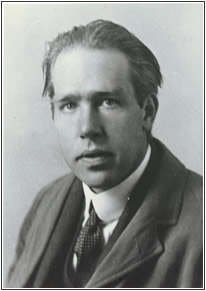
You are here: Home >> History of Light >> Quantum Mechanics >> ...from N. Bohr
 N. Bohr was the first scientist who proposed a new structure for atoms. Atoms should be a miniature of a solar system. Electrons follow circular orbits around the core according to laws of classical Physics.
N. Bohr was the first scientist who proposed a new structure for atoms. Atoms should be a miniature of a solar system. Electrons follow circular orbits around the core according to laws of classical Physics.
When a photon runs against an electron the electron absorbs the photon's energy and it immediately pinnacles to an upper orbit. Almost immediately again the electron returns to its previous state emitting a photon of the same frequency. At the same time, electrons could not follow spiral orbits and fall onto the core emitting radiation during their fall, because electrons should emit energy in quanta. This assumption justified the constant orbits of electrons. Each orbit corresponds to a specific of quantity of energy. Thus, intermediary energy levels do not exist.
Bohr's evolutionThe new structure of atom arouse many questions about photons and consequently about light. Bohr's work offered to scientists a stable base for further discussions. We now know that the structure of atom that he proposed is not accurate, but this does not affect his endeavour and the fact that he made Quantumechanics more reliable. For this work he received the Nobel Prize for Physics in 1922.
Related links (external pages)